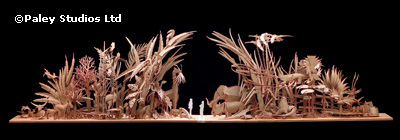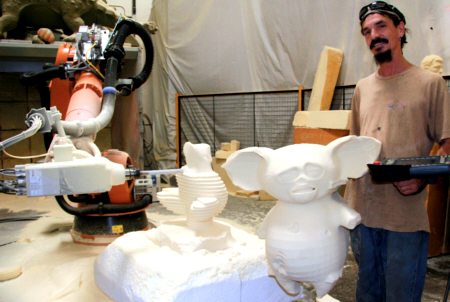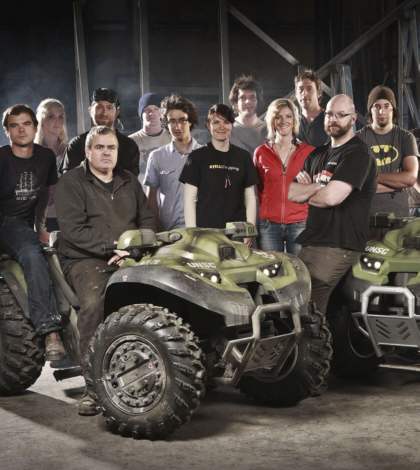Paley Studios Ltd, the team behind celebrated American master metal sculptor Albert Paley, have used raster-to-vector conversion software to turn hundreds of scanned paper profiles of animals and plants into AutoCAD files for a giant new steel sculpture for the St. Louis Zoo.
The animal and plant profiles will be cut from Cor-Ten hot rolled plate steel using CNC plasma technology. As the scale model image above shows, this awesome metal sculpture promises to be a very exciting new attraction at St Louis Zoo.
Albert Paley
Albert Paley made his name initially as an art jeweller in New York and in 1969 moved to Rochester, New York to teach at the Rochester Institute. With the recognition he earned from the Renwick Gallery “Portal Gates” for the Smithsonian National Museum of American Art in Washington, DC, (forged and fabricated steel, brass, bronze, and copper, 1974), he switched permanently to metal sculpture and decorative arts.
Since 1974 Paley has completed over 50 major corporate and civic commissions. Among the notable examples his major work are the “Passage” for the Federal Building in Asheville, NC, (formed and fabricated weathering steel, 1995); and the “Genesee Passage” for Bausch and Lomb’s corporate headquarters, Rochester, NY, (formed and fabricated weathering steel, 1996). His inventive approach to form development and metal technique was recognized by the AIA (American Institute of Architects) in 1995 when they awarded him their coveted Institute Honors Award for his integration of art and architecture.
 At his studio in Rochester, NY, Paley and his staff work in a variety of metalworking disciplines. Paley employs 12 full-time people including fabricators, project planners, archivists and administrators. The sculptor produces the designs and takes a key role in the construction of his sculptures. The current project is a 100 ton Cor-ten steel sculpture for the St. Louis Zoo which will be 125 feet in length, 32 feet tall and 10 feet wide when finished. The initial proposal for the project included a complete scale model constructed in cardboard.
At his studio in Rochester, NY, Paley and his staff work in a variety of metalworking disciplines. Paley employs 12 full-time people including fabricators, project planners, archivists and administrators. The sculptor produces the designs and takes a key role in the construction of his sculptures. The current project is a 100 ton Cor-ten steel sculpture for the St. Louis Zoo which will be 125 feet in length, 32 feet tall and 10 feet wide when finished. The initial proposal for the project included a complete scale model constructed in cardboard.
St Louis Zoo Sculpture
The finished zoo sculpture will feature over 600 elements that include aquatic and land animals, birds and vegetation. It consists of Cor-Ten hot rolled plate steel in various thicknesses, from as thin as .25 inch for animal details to 1.5 and 2 inches thick for animal profiles and plant leaves. In order to create the forms represented by the artist the work is hydraulically formed and heat bent prior to welding.
“Our normal construction procedure starts with a representative drawing which is broken down into drawings of each element. These are then transferred to cardboard to construct a scale model. Patterns are then developed which are sent to our steel supplier to be traced on the burn table with a laser eye, then burned out of the plate steel using conventional CNC plasma technology” said project manager Robert Chan.
 The inefficiency of working with paper patterns in a modern CNC environment led the studio to recognize that the use of AutoCAD would offer significant benefits. For example, as CAD files the patterns can be scaled up or down as required, then cut directly without the need for tracing around the paper pattern, a cost-saving. But before they could get the advantages of using AutoCAD files they first had to get the the artist’s existing hand sketches and patterns into AutoCAD for editing. This is where Scan2CAD raster-to-vector conversion software provided a practical solution.
The inefficiency of working with paper patterns in a modern CNC environment led the studio to recognize that the use of AutoCAD would offer significant benefits. For example, as CAD files the patterns can be scaled up or down as required, then cut directly without the need for tracing around the paper pattern, a cost-saving. But before they could get the advantages of using AutoCAD files they first had to get the the artist’s existing hand sketches and patterns into AutoCAD for editing. This is where Scan2CAD raster-to-vector conversion software provided a practical solution.
Scan2CAD
Chan found Scan2CAD after trying other products and services with varying degrees of success. Scan2CAD is a raster-to-vector converter that turns uneditable scanned raster images into CAD-editable vector DXF files.
“Scan2CAD seemed to do the best job of converting our scanned images saved as TIFF raster files to vector DXF format for use with AutoCAD. We hired an AutoCAD technician to this position and he learned Scan2CAD very quickly” said Chan.
Paley Studios had two main requirements. The first was that the DXF vector files had to be an almost exact match to the artist’s scanned hand sketch; the second was that the converted hand sketches should need as little tidying-up in AutoCAD as possible. By first creating good quality scans of the sketches Paley Studios were able to follow a set raster to vector conversion procedure in Scan2CAD that ensured good results.
 Scan2CAD converts the sketch and pattern outlines into a tight-fitting DXF file made up from lines, polylines (joined lines and arcs) or Bezier curves. the Bezier curves can be exported to AutoCAD as splines, polylines or arcs.
Scan2CAD converts the sketch and pattern outlines into a tight-fitting DXF file made up from lines, polylines (joined lines and arcs) or Bezier curves. the Bezier curves can be exported to AutoCAD as splines, polylines or arcs.
“With Scan2CAD technology in-house we greatly increased our flexibility and control of our patterns so that each piece can be burned exactly to our specification or modified easily without having to recreate the paper pattern and pay for any extra time on the burn table for tracing. Our ability to integrate Scan2CAD raster to vector conversion technology with AutoCAD has developed time and cost saving factors which Paley Studios will use well into the future” Chan said.
Paley Studios is now nearing completion of the pattern creation phase. A significant benefit from their use of Scan2CAD and AutoCAD is that in addition to supplying their steel supplier with full-size patterns to cut they can also quickly resize the patterns to produce a Cor-ten steel scale model of whatever project they are designing, developing or constructing.
The St Louis Zoo sculpture is scheduled for unveiling in May or June 2006.
www.albertpaley.com
www.softcover.com







